Around 5 % of the territory of Budapest is under protection by the Duna-Ipoly National Park, and 1,6 % is protected by the Budapest Municipality. In these protected habitats several Pannon endemic species live, some species are threatened according to the IUCN Red List of Threatened Species. Presently, there are not enough financial sources to protect and manage these areas in Budapest. Therefore, the political leaders of local governments, conservationist NGOs and local communities debate about how to manage these protected areas. Furthermore, it is frequently asked why it is important to reserve these fragmented and often small areas in an urbanized area, like Budapest. The national park and the NGOs have more professional skills and tender possibilities (LIFE+, Environment and Energy Operative Program) to manage the protected areas than the local governments or Budapest Municipality, because the latter organizations receive financial resources only from the central government budget and from local taxes. Moreover thanks to protection and to professional management, we can use geoand biodiversity as tourist attractions, which can make a profit for the proprietor.
- Introduction
Budapest is not only the capital city, but also the cultural, economic and industrial centre of Hungary. The city is located along the River Danube. The Buda side of the city is hilly, while the Pest side was built on the flood plain of the Danube River. Approximately 1.7 million people — 17 percent of the total population of Hungary — live in Budapest. The city has high population density, about 3300 people per square km (www.ksh.hu).
Today urbanization threatens natural values. Over the past few years, several residential quarters, malls and paved roads were built, destroying various valuable habitats. Furthermore, cutting the ecological corridors causes the fragmentation and degradation of green areas (Beluszky, 2007) [1]. For example, a housing estate was built in Csepel destroying around 5 hectare of sandy grassland vegetation in 2003 (Tenk et al., 2014) [2]. The Buckthorn Nature Protected Area of Újpest is threatened by road constructions fragmenting the area of the sandy grassland. The surroundings of Apáthy Rock or the Quarry of Fazekas Hill are threatened by cutting the ecological corridors (Bajor, 2009) [3].
- Protected areas in Budapest
The landscape in Budapest is varied. The Buda side has forests, rocks, caves and highland, which serve as the habitat of many endemic plant and animal species. The green areas of the Pest side also have great importance in the conservation of wetlands, meadows and sand dunes. These sites are of primary importance according to the European nature conservation policy (The Habitats Directive). Furthermore, there are several Natura 2000 areas, for example on both sides of the Danube and in the Buda Hills. These include for example Alluvial forests with Alnus glutinosa and Fraxinus excelsior (Natura 2000 code: 91E0), Rupicolous pannonic grasslands (Natura 2000 code: 6190), Sub-Pannonic steppic grasslands (Natura 2000 code: 6240) Caves not open to the public (Natura 2000 code: 8310) etc. (www.termeszetvedelem.hu).
According to the Budapest Municipality Decree no. 25/2013 the Hungarian capital has 27 locally protected areas and 12 protected trees on around 850 hectares (www.termeszetvedelem.hu) [4].
List of protected areas by Budapest Municipality (based on Budapest Municipality Decree no. 25/2013)
T a b l e 1

Furthermore, 10 areas (hills, meadows, sand dunes, caves, gardens) and 6 swamps are protected by the Duna-Ipoly National Park on around 2700 hectares. The swamps are «ex lege» protected areas without management (Act LIII. of 1996 on Nature Protection). The total area of the swamps is around 80 hectares and they can be found in the eastern and southern parts of Budapest (Bajor, 2009) [3].
List of protected areas by the Duna-Ipoly National Park (based on data of Ministry of Rural Development Decree 129/2011) 1
T a b l e 2
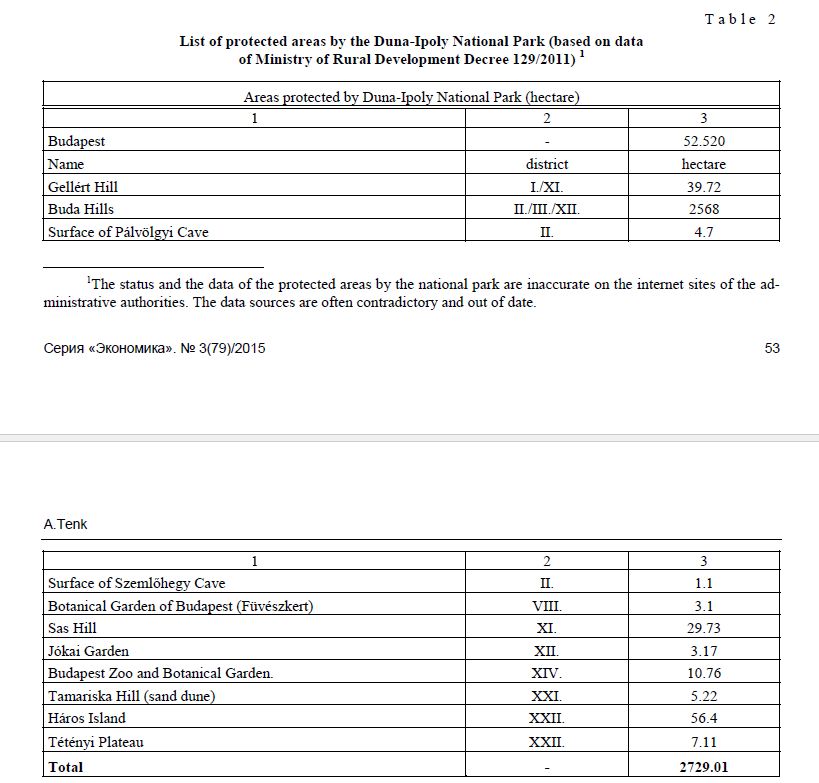
Among the protected areas there are Natura 2000 sites, for example parts of the Buda Hills, the Tétényi Plateau and the lower reaches of the River Danube (www.dinpi.hu) [5].
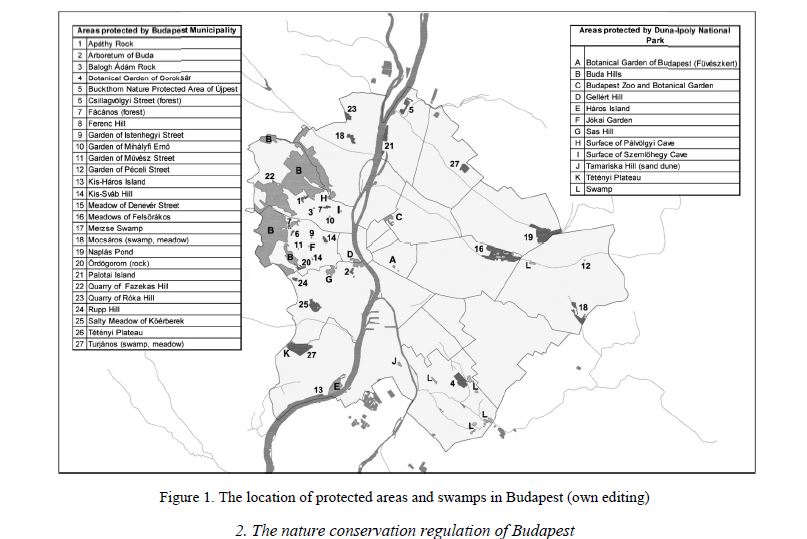
Figure 1. The location of protected areas and swamps in Budapest (own editing)
- The nature conservation regulation of Budapest
Due to the dual local government system, the capital has great bureaucracy on the field of nature protection. The administration of the Hungarian capital and its districts is regulated in a separate law. Budapest has a peculiar two-tier administration system. There are twenty-three districts with their own local governments and there is Budapest Municipality with its own regulation. The districts directly elect representatives — today the mayors of the districts and directly elected council members — who form the basis of the city’s selfgovernment (www.budapest.hu) [6]. This offers the possibility of free bargaining between the districts and Budapest Municipality. But this dual system has some problems in the field of nature protection.
The Minister of Agriculture (and under-secretary), the administrative authority and the town clerk of local governments (and Budapest Municipality) manage the administration of nature conservation regulation. According to the new Act CLXXXIX of 2011 on Local Governments and the Act LIII. of 1996 on Nature Protection, the Budapest Municipality has the right to establish or delist a protected area in agreement with the districts, and it has the right to change the status of a protected area. However, the districts have the right to veto this decision. Furthermore, the Ministry of Agriculture has the right to set up a protected area anywhere in Hungary, including the capital. And any Hungarian citizen has the right to initiate the protection of an area [7].
The status of the territory in question can be changed after a thorough investigation of the area. National Parks and NGOs must be involved in the pronouncing process. For Natura 2000 sites and all protected areas in Budapest the Middle-Danube-Valley Inspectorate for Environmental Protection, Nature Conservation and Water Management (abbr. KDV-KTF) is the competent authority (www.fori.hu) [8].
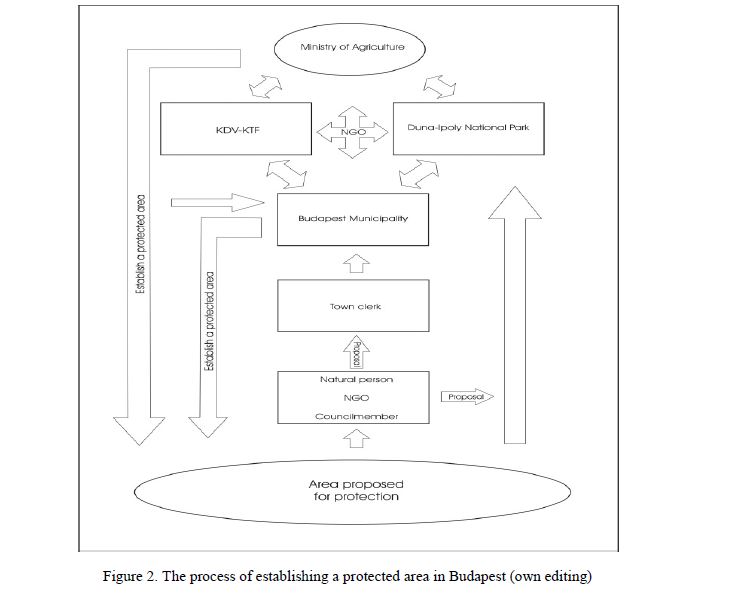
Figure 2. The process of establishing a protected area in Budapest (own editing)
As a result of a recent decision of the Hungarian Parliament, the Inspectorates for Environmental Protection, Nature Conservation and Water Management will be subordinated to the Government Offices from 2015 (Act VI. of 2015) [9].
Independently of the results of the professional decision-making process, the city council has the right to establish or to delist a protected area in Budapest. The council members are elected politicians, and their decisions are mainly political, not professional. However, establishing or delisting a protected area should not be a political question, but a professional one. Additionally, the final decision of the city council is difficult to change, only the Minister of Agriculture can modify it. Unfortunately, the national parks have not enough possibility2 to influence the decisions of the Ministry because the Ministry makes the final decision.
- Management and touristic development of protected areas in Budapest
One of the goals of the protection of green areas is to create and to manage a network of natural areas in Budapest. And to achieve these goals it is necessary to effectuate the following (Font and Brasser, 2002) [10]:
2A recent bill (T/3788) interferes with the rights of national parks.
- to develop well-managed, protected natural areas which can welcome visitors;
- to create a cooperation between the authorities of protected areas, the local population and commercial and nature conservationist organizations (NGOs);
- it is important to balance between nature conservation, local development, tourism and recreation;
- we need to avoid potentially conflicting
Furthermore, wildlife protection is important not only for ethical and moral reasons, but for recreational benefits, and for economic and touristic reasons. People have realized that the presence and protection of wildlife can improve their lives (Steiner, 2008; Huszti 2012.) [11, 12].
When we investigate the network of the protected areas, we can find few «best practices» of the management of protected areas in Budapest. Following these examples, it is possible to increase the number of well-managed protected areas. And the well-managed areas will attract more visitors in the future.
The Sas Hill and the Szemlő Cave is managed by the Duna-Ipoly National Park, while the majority of the protected areas are managed by Budapest Municipality cooperating with Főkert Non-profit Ltd., the gardener entrepreneur of Budapest Municipality (www.fokert.hu).The Buckthorn Nature Protected Area of Újpest (Újpesti Homoktövis Természetvédelmi Terület) is managed by the BirdLife Hungary (The Hungarian Ornithological and Nature Conservation Society, abbr. MME) and the Tétényi Plateau Protected area is managed by the Green Future (Zöld Jövő) NGO. The Tamariska Hill is only managed by Csepel local government with the leading of the Duna-Ipoly National Park.
The most important recent developments were the touristic development of the Cave of Szemlő Hill, the Sas Hill and the historical Garden of Jókai Mór by the Duna-Ipoly National Park in Budapest. The support intensity was 75 % by the European Union.
Applications of the Duna-Ipoly National Park in Budapest (based on the data of Duna-Ipoly National Park)
T a b l e 3
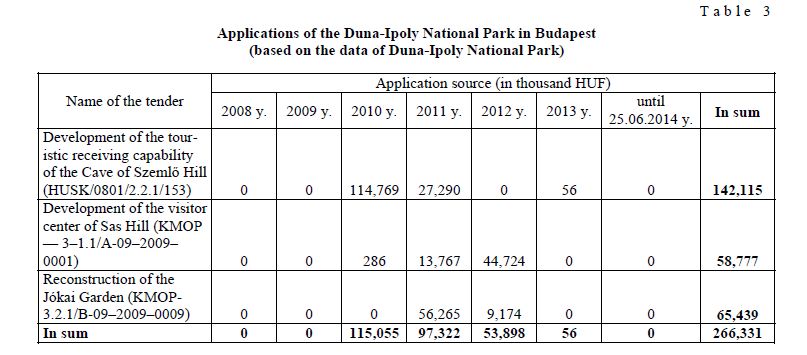
The main project of the Cave of Szemlő Hill was the reconstruction of the reception building and of the park around it. Furthermore, a geological demonstration center was created with an interactive exhibition. Now the whole area is accessible for the disabled, and nature trail was also created (www.dunaipoly.hu).
The goal of the development of the Sas Hill was to create and to develop a visitor center. The main part of the project was to build a terrace with panorama, to renew the nature trail and to make the territory accessible for the disabled. The full reconstruction of the Jókai Garden took place between 2011–2012.
The national park has some income from entrance fees. But the incomes of Füvészkert and Budapest Zoo and Botanical Garden are not realized either at the national park or at Budapest Municipality. The Füvészkert belongs to the Eötvös Lóránd University (ELTE) and the Zoo is a stand-alone budget-funded organization. The maintainer and the supervisor of the Zoo is the Budapest Municipality3 (www.zoobudapest.com) [13].
3The local government has no income from the Budapest Zoo according to the information of Budapest Municipality.
Income form the visitor’s entrance fee of the Duna-Ipoly National Park (based on the data of Duna-Ipoly National Park)
T a b l e 4
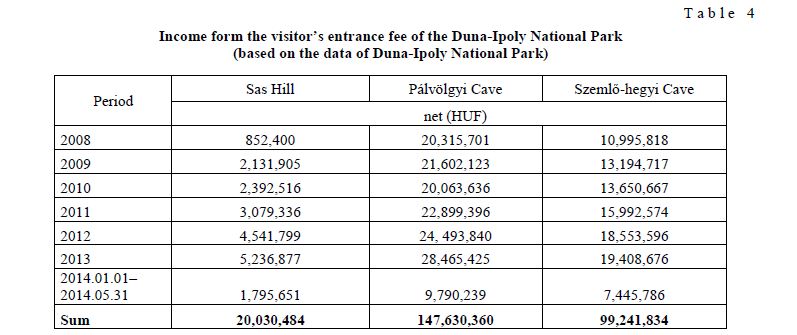
For example the Botanical Garden of Soroksár belongs to the Faculty of Horticultural Science of the Corvinus University of Budapest (http://sorbotkert.hu). For the entrance fee the visitors can get a guided tour.
Nature trails in Budapest
Nature trails show the natural values, the cultural history and the importance of conservation, and the management of the protected area (Kiss 1999) [14]. In addition to the above developments of protected areas, nature trails were also established. Nowadays there are 15 nature trails and a few of information boards at the typical natural habitats of Budapest. These trails were built by the MME and other NGOs together with the Duna-Ipoly National Park The financial support was given mainly by the Budapest Municipality and the national park (Bajor-Lampert R. — Bajor Z. 2013) [15]. The national park built nature trails only in areas it manages alone or together with the local government, for example in the Sas Hill or the Tamariska Hill. Due to this fact, there are different systems of the nature trails in Budapest.
The examination of these nature trails shows that there are problems of varying degrees to be solved (Dávid 2012) [16]:
- to keep track of the number of visitors of the nature trails;
- to connect the nature trails with transport hubs (the trails are isolated in many cases);
- to prevent and to repair the damage done by visitors;
- the continuous maintenance of nature trails;
- information boards are generally very didactic (For example a small interactive board can help teach the basics of nature protection for children
What is the main difference between nature trails? The nature trail of the Tamariska Hill shows the nature values of the area, but it has no interactive part. The nature trail of Buckthorn Nature Protected Area of Újpest has an interactive board showing the nature values of the area for the children. The nature trail of Tétényi Plateau can only be used with the help of a brochure, because the nature trail has only «check points» without information boards. The brochure guide can be obtained in the office of Zöld Jövő Society. The Quarry of Róka Hill has no nature trail, only one board showing the geological values without describing the biodiversity of the protected area.
Consequently, Budapest nature trails are really diverse. However, it would be better to built unified nature trails. Why? The nature trails built by the Duna-Ipoly National Park or by the MME show several features of the given area, e.g biodiversity, geodiversity or cultural history. Other nature trails focus for example on the geology or the flora and fauna only. Some nature trails can only be used with the help of the associated brochure guide. The unification should not apply to the appearance or the format of nature trails — just the type of information presented.
Toursistic information about the protected areas
It is difficult for the tourists to get information about the protected areas in Budapest. There is not correct touristic information on the Internet and the books or flyers in English are often too short and superficial. For example, one can read about the protected areas on the www.fori.hu, but only in Hungarian and there is not a correct map representing the routes leading top protected areas, or the access by public transport or by bicycle. The same problem is present on the website of the Duna-Ipoly National Park (www.dinpi.hu). One of the most informative websites is the http://zoldkalauz.hu, but the foreign tourist can not read it in English either. There is a description of caves at www.budapest.com in English and www.lonelyplanet.com writes about the green areas.
The official governmental websites — www.termeszetvedelem.hu — present correct data, but these are useful for professionals not for the tourists. The homepages of local governments have correct information about the protected areas in their district, but these pages are rarely accessible in English. In sum, the necessary information might be present on several websites, it would be useful to create a multilingual website specialized in natural values.
- Conclusion
The protected areas in Budapest are managed by the Budapest Municipality and by the Duna-Ipoly National Park. But these organizations have not enough income from the state budget. They have possibilities to obtain money from the tenders of the European Union or from entrance fees of tourists. Consequently, the areas should be made profitable.
Therefore it is important to manage the green areas well, for example to built nature trails and demonstration centers with interactive exhibitions, or offer guided tours with the help of NGOs. Furthermore, the judicial protection of the protected areas and the manager organizations must be guaranteed. Unfortunately there is more and more difficulty in the regulation of the nature protection. For example new laws restrict the rights of the national parks.
Nevertheless, there are some protected areas in Budapest which had been developed in the last years by the Duna-Ipoly National Park or by the MME and local governments. If these places were advertised more efficiently online or with the help of the Geographical Information System (GIS), more tourists would visit them, and the areas could make more profit. These areas could serve as model territories for other protected areas in the city of Budapest.
References
- Beluszky P. (szerk.): Közép-Magyarország [Central Hungary] Dialóg Campus, Pécs-Bp. — 2007. — Р. 526. — Рр.
- Tenk A., Merkl O., Gergely A. (2014): Csepel természeti képe [The physiography of Csepel]. — P. 116. — Pр. 88–89.
- Bajor Z. (2009): Budapest természeti kalauza [The nature guide of Budapest]. Kossuth Kiadó, — P. 256. — Pр. 44–65. 103–112. 121–125.
- Természetvédelmi prioritások és célkitűzések [Nature protection priorities and aims] — termeszetvedelem.hu/_user/browser/File/Natura2000/SAC_Celkituzesek/DINPI_SAC_celkituzesek/HUDI20009.pdf) Helyi jelentőségű védett természeti területek [Local protected areas] — www.termeszetvedelem.hu/helyi-jelentosegu-vedett-termeszetiteruletek#2014
- Duna-Ipoly Nemzeti park [Duna-Ipoly National Park] — dinpi.hu
- Budapest Főváros Önkormányzatának hivatalos oldala [The administrative site of Budapest Municipality] — budapest.hu
- évi CLXXXIX. törvény Magyarország helyi önkormányzatairól [Act CLXXXIX of 2011 on Local Governments of Hungary]
- Fővárosi Rendészeti Igazgatóság: Természetvédelem Budapesten [Nature protection in Budapest] — fori.hu/termeszetvedelem-budapesten.
- évi VI. törvény egyes közigazgatási tárgyú törvények módosításáról [Act VI. of 2015. on the modification of some public administration laws].
- Font X., Brasser A. (2002): PAN Parks: WWF’s sustainable tourism certification programme in Europe’s national parks. in: Sustainable Tourism: A Global Perspective, Edited by Harris et al., Butterworth-Heinemann, Oxford. — P. 312. — P. 105.
- Steiner F. (2008): The Living Landscape. Island Press, Washington. — P. 496. — P.
- Huszti Zsolt (2012): Integration of «made cities» to physical environment. In: Development of the Settlement Network in the Central European Countries, Springer, Deutschland. — P. 235–244.
- Állatkerti alapadatok [Facts on the Zoog — zoobudapest.com/rolunk/allatkerti-alapadatok.
- Kiss G. (1999): Hogyan építsünk tanösvényt? [How to build a natural trail?]. Földtani Örökségünk Egyesület, — P. 126. — P. 15.
- Bajor-Lampert R., Bajor Z. (2013): Budapest tanösvényei a környezeti nevelés szolgálatában [The role of nature trails of Budapest in environmental education]. Madártávlat, XX./ 3. — P. 34–39.